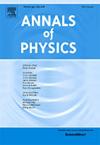Stellar isotropic model in the symmetric teleparallel equivalent of general relativity theory
IF 3
3区 物理与天体物理
Q2 PHYSICS, MULTIDISCIPLINARY
引用次数: 0
Abstract
Recently, the theory of symmetric teleparallel equivalent of general relativity (STEGR) has gained much interest in the cosmology and astrophysics community. Within this theory, we discuss the method of deriving a stellar isotropic model. In this respect, we implement the equations of motion of STEGR theory to a spacetime that is symmetric in a spherical manner, resulting in a set of nonlinear differential equations with more unknowns than equations. To solve this issue, we assume a special form of , and suppose a null value of the anisotropy to obtain the form of . We then investigate the possibility of obtaining an isotropic stellar model consistent with observational data. To test the stability of our model, we apply the adiabatic index and the Tolman–Oppenheimer–Volkoff equation. Furthermore, we examine our model using different observed values of radii and masses of pulsars, showing that all of them fit in a consistent way.
广义相对论对称远平行等效理论中的恒星各向同性模型
近年来,广义相对论的对称远平行等效理论(STEGR)引起了宇宙学和天体物理学界的极大兴趣。在这个理论中,我们讨论了推导恒星各向同性模型的方法。在这方面,我们将STEGR理论的运动方程实现到一个以球面方式对称的时空,从而得到一组未知数多于方程的非线性微分方程。为了解决这个问题,我们假设gtt的一种特殊形式,并假设各向异性的一个空值,从而得到grr的形式。然后,我们研究了获得与观测数据一致的各向同性恒星模型的可能性。为了检验模型的稳定性,我们采用了绝热指数和Tolman-Oppenheimer-Volkoff方程。此外,我们使用脉冲星的半径和质量的不同观测值来检验我们的模型,表明它们都以一致的方式拟合。
本文章由计算机程序翻译,如有差异,请以英文原文为准。
求助全文
约1分钟内获得全文
求助全文
来源期刊

Annals of Physics
物理-物理:综合
CiteScore
5.30
自引率
3.30%
发文量
211
审稿时长
47 days
期刊介绍:
Annals of Physics presents original work in all areas of basic theoretic physics research. Ideas are developed and fully explored, and thorough treatment is given to first principles and ultimate applications. Annals of Physics emphasizes clarity and intelligibility in the articles it publishes, thus making them as accessible as possible. Readers familiar with recent developments in the field are provided with sufficient detail and background to follow the arguments and understand their significance.
The Editors of the journal cover all fields of theoretical physics. Articles published in the journal are typically longer than 20 pages.
 求助内容:
求助内容: 应助结果提醒方式:
应助结果提醒方式:


